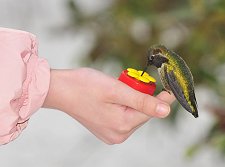|
Winter Feeding Anna's Hummingbirds
By Gord Gadsden
Hummingbirds are understandably associated with the spring or summer months. This used to be true in most of B.C. until the hardy and non-migratory Anna's Hummingbird moved in. Now, one can see hummingbirds twelve months of the year which is still a unique experience for many in B.C.

History of the Anna's Hummingbird
Originally, Anna's Hummingbirds were commonly found in California as year-round residents. However, a combination of milder winters and the planting of exotic vegetation that provided more natural nectar sources caused these birds to move northwards. Victoria, B.C., with the mildest of winters, had a small population first, but it wasn't long before birds started to be seen in Vancouver. In the early 2000's or so Anna's Hummingbirds started to be regularly found in Abbotsford and it wasn't long before they are where they are now; a very common sight in the Upper Fraser Valley up as far as Hope. Some recent sightings have even been recorded in the Interior and as far north as Fort St. John! While the trend of warmer winters has helped, backyard hummingbird feeders have played an important role especially during cold snaps.
How do they Survive?
Anna's Hummingbirds are among the more insectivorous of the hummingbirds. They will capture and eat small insects to supplement their nectar diet. This is especially important when flowers that provide natural nectar is not available. But when the weather gets below freezing, their insect food source disappears. These birds are very hardy and will go into a torpor where their breathing and heart rate slows to help them survive the night and cold periods. But if the cold weather lasts too long, they will not survive. This is where backyard hummingbird feeders are especially important to help them survive. People have come up with inventive ways to keep the feeder's sugar water from freezing by using hand warmers and lights. Our Facebook page has several examples. Some people have even taken the extra step of using hand feeders which is a very rewarding and special experience. The video below shows this very well.
Final Tips
1) First consider carefully if you're going to feed hummingbirds past September when the migratory hummingbird species are typically gone for the winter. If the potential commitment to keep feeders unfrozen during a possible cold snap isn't possible or is unappealing (it can be a LOT of work!) take down your feeders. While the Anna's Hummingbird won't migrate regardless of your feeder being up or not, they will seek out alternate food sources and be better prepared to meet a cold spell if it happens.
2) Use 1 part white granulated sugar to 4 parts water. Avoid the temptation to use a higher ratio of sugar to water as this will only dehydrate the birds and will not provide any extra food value. Never use honey, food colour or anything else to feed your hummingbirds
3) Swapping feeders throughout a cold day is very popular among those who feed the hummingbirds especially if a warming source (light, heating pad etc) is not available or feasible.
4) Hummingbirds are very territorial. If you have several in your yard, try hanging a few feeders in different locations out of sight from each other. Otherwise, if too close together, the most dominant hummingbird will monopolize all the feeders and make it hard for the others to feed.
5) While not as much an issue in cooler weather as it is in the summer, wash your feeder regularly and put just enough food in the feeder to last 5-6 days.
More information on feeding hummingbirds can be found by clicking here.
Good luck and enjoy your hummingbirds. If you have any questions, do feel free to ask on the discussion forum or on our Facebook page.

|


